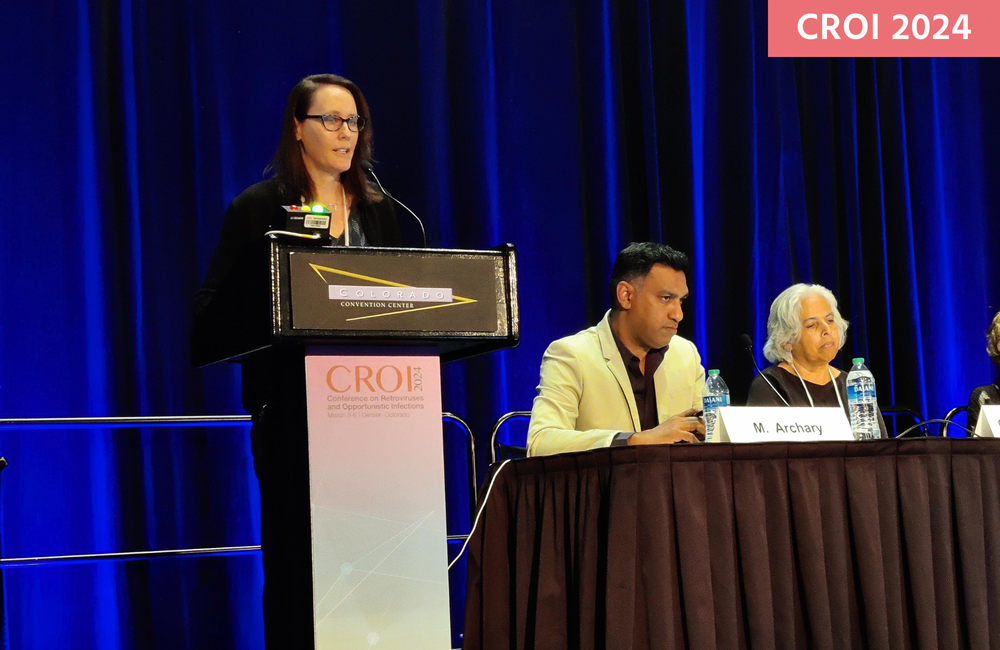
Dolutegravir did not increase the risk of high blood pressure (hypertension) during pregnancy in a large international study, but mildly raised blood pressure was common in young women with HIV, Professor Risa Hoffman reported on behalf of the IMPAACT 2010 study team at the Conference on Retroviruses and Opportunistic Infections (CROI 2024) in Denver last week.
Another large observational study found that although the risk of developing high blood pressure during pregnancy was slightly higher in women taking dolutegravir compared to efavirenz, women with HIV had a lower risk of developing high blood pressure during pregnancy than women without HIV.
Modest increases in blood pressure during pregnancy are common. In approximately 8-10% of pregnancies, high blood pressure develops. In its most severe form, high blood pressure in pregnancy can develop into pre-eclampsia, a condition which raises the risk of stillbirth, premature birth and maternal seizures.
However, antiretroviral treatment reduces the risk of high blood pressure during pregnancy and pre-eclampsia in women with HIV.
Blood pressure changes in IMPAACT 2010
IMPAACT 2010 was a large randomised comparative study of the effectiveness and safety of two antiretoviral regimens initiated during pregnancy. The study compared dolutegravir- and efavirenz-containing regimens, and also compared two formulations of tenofovir when combined with dolutegravir and emtricitabine. The study showed that women who started dolutegravir-based treatment during the second trimester of pregnancy were more likely to have a suppressed viral load at the time of delivery than women randomised to receive efavirenz. A suppressed viral load at the time of delivery greatly reduces the risk of vertical HIV transmission.
The study also found that women who received dolutegravir were less likely to experience adverse pregnancy outcomes such as stillbirth and low birth weight for gestational age, and that greater weight gain during pregnancy reduced the risk of these outcomes.
Professor Risa Hoffman of University of California Los Angeles presented a post-hoc analysis of changes in blood pressure in trial participants. The study enrolled 643 women in 11 countries. Participants were equally assigned to the three study regimens at between 14 and 28 weeks of gestation.
Blood pressure was measured every four weeks during pregnancy, at the time of delivery and five times during the 50-week postpartum follow-up period. The analysis identified new cases of high blood pressure and pre-eclampsia during pregnancy and up to 12 weeks after giving birth.
Blood pressure increases were categorised as elevated (130-139 or 80-89mmHg) or as stage 1-3 hypertension. If high blood pressure developed from week 20 of gestation onwards and resolved by 12 weeks after delivery, it was classified as gestational hypertension (temporarily raised blood pressure associated with the pregnancy).
Participants had a median age of 26 years, 86% were enrolled in Africa, and the mean body mass index (BMI) at enrolment was 25.9. At study entry, high blood pressure was rare, detected in 2.6% of participants.
During the study, the proportions diagnosed with elevated blood pressure ranged from 40% in the efavirenz study arm to 46% in the dolutegravir / emtricitabine / tenofovir alafenamide arm. Mild gestational hypertension was diagnosed in 3.4% of efavirenz recipients, 2.9% of dolutegravir / tenofovir disoproxil / emtricitabine recipients and 1.9% of dolutegravir / tenofovir alafenamide / emtricitabine recipients. Severe gestational hypertension was diagnosed in one dolutegravir / tenofovir alafenamide / emtricitabine recipient and one efavirenz recipient.
Eight cases of pre-eclampsia and one of eclampsia were reported during the study; four of the eight cases of pre-eclampsia occurred in women taking dolutegravir / emtricitabine / tenofovir alafenamide.
There was no association between antiretroviral regimen and the risk of developing high blood pressure. Weight was the critical factor: for every 5kg increase in weight, the risk of developing high blood pressure increased by 16 to 22%.
“Given the importance of dolutegravir-based ART as a well-tolerated and highly effective regimen globally, a focus on healthy body weight, particularly pre-conception, may help optimize outcomes over recurrent pregnancies as well as health over a woman’s lifespan,” Dr Hoffman concluded.
More data
Two other studies showed no substantial difference between antiretroviral regimens in the development of high blood pressure during pregnancy or in the postpartum period.
In Botswana, an analysis of the Tsepamo study of pregnancy outcomes in women with and without HIV found that women without HIV (n=117,309) had a 20% higher risk of developing high blood pressure during pregnancy compared to women with HIV taking dolutegravir (n=5866). Women taking efavirenz (n=4771) had a 20% lower risk than women taking dolutegravir, but the overall incidence of gestational hypertension was low – 10% in women taking dolutegravir and 8% in women taking efavirenz. The rate of severe gestational hypertension was low, at around 1%.
In the DOLPHIN-2 randomised trial, carried out in South Africa and Uganda, women with HIV who initiated treatment late in pregnancy (from week 28) were assigned to dolutegravir- or efavirenz-based antiretroviral regimens. A secondary analysis of the trial looked at postpartum weight gain and found no significant difference in the emergence of new cases of high blood pressure 6, 24, 48 or 72 weeks postpartum according to antiretroviral regimen.
Hoffmann R et al. Hypertension in a randomized trial of DTG vs EFV-based ART in pregnant and postpartum women. Conference on Retroviruses and Opportunistic Infections, Denver, abstract 183, 2024.
View the abstract on the conference website.
Jacobson DL et al. Hypertension in pregnant persons by HIV status and by DTG vs EFV use in Botswana. Conference on Retroviruses and Opportunistic Infections, Denver, abstract 910, 2024.
View the abstract on the conference website.
Malaba TR et al. DTG Versus EFV initiation in pregnancy is not associated with postpartum blood pressure. Conference on Retroviruses and Opportunistic Infections, Denver, abstract 918, 2024.
